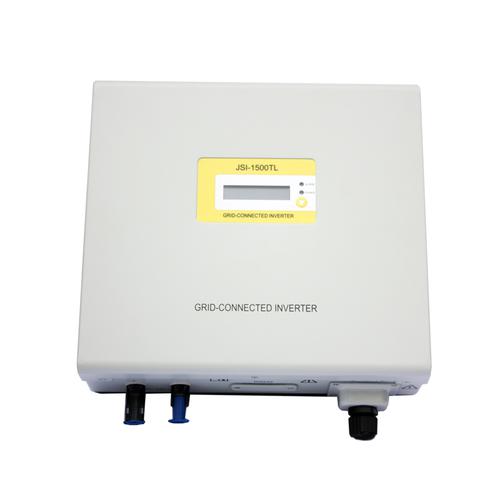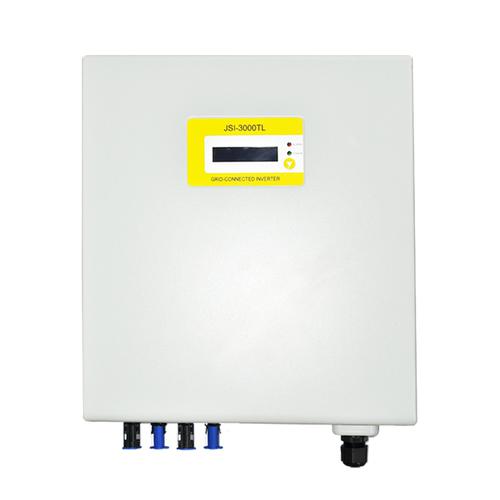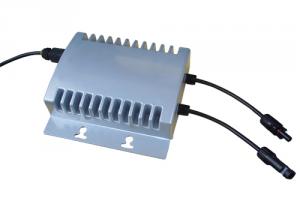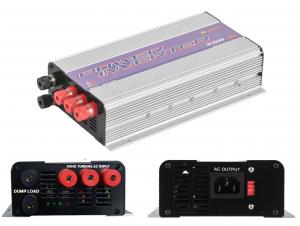Grid tie solar inverter 2500W
OKorder Service Pledge
Quality Product, Order Online Tracking, Timely Delivery
OKorder Financial Service
Credit Rating, Credit Services, Credit Purchasing
You Might Also Like
Grid tie solar inverter 2500W
◆ Compact size and high power density
◆ High speed MPPT for real time power tracking and improved energy harvesting
◆ Transformerless operation for highest efficiency 97%
◆ High overload capability under most ambient conditions
◆ Certified grid connected operation according to the international standards
◆ True sine wave output
◆ Integrated RS485/RS232 serial communications
◆ Multi-language LCD display
| MODEL | 1100TL | 1500TL | 2000TL | 2500TL | 3000TL | 3600TL | 5000TL | 6000TL |
| Max. DC Input Power(W) | 1200 | 1750 | 2300 | 2700 | 3660 | 3750 | 5300 | 6400 |
| Max DC Voltage(Vdc) | 450 | 450 | 500 | 550 | ||||
| MPPT Operating Range(Vdc) | 60~450 | 100~450 | 100~500 | |||||
| Number of Parallel Inputs | 1 | 2 | 3 | |||||
| Number of MPPT Trackers | 1 | |||||||
| Max. Input Current(A) | 11.7 | 10 | 13 | 14.5 | 20 | 20 | 22.5 | 27.5 |
| Nominal Output Power(W) | 1100 | 1500 | 2000 | 2490 | 3000 | 3600 | 4600 | 6000 |
| Max. Output Power(W) | 1100 | 1650 | 2200 | 2490 | 3400 | 3600 | 5000 | 6000 |
| Nominal Output Current(A) | 4.8 | 6.5 | 8.7 | 10.8 | 13 | 15.7 | 20 | 26 |
| Max. Output Current(A) | 5.7 | 7.9 | 10.5 | 12 | 15.7 | 16 | 24 | 29.3 |
| Nominal AC Output Voltage(Vac) | 230 | |||||||
| AC Output voltage range (Vac)* | 190~265 | |||||||
| AC Grid frequency range (Hz)* | 50±5 | |||||||
| Power Factor (cosφ) | >0.99 | |||||||
| THDI | <3%(at nominal output power) | |||||||
| Max.efficiency | 96.50% | 96.50% | 97.00% | 97.10% | 97.20% | 97.30% | 97.40% | 97.40% |
| Euro.efficiency | 95.40% | 95.50% | 96.20% | 96.30% | 96.40% | 96.60% | 96.80% | 96.80% |
| MPPT. efficiency | 99.60% | 99.60% | 99.60% | 99.60% | 99.60% | 99.60% | 99.60% | 99.60% |
| Operating Temperature(℃) | -25~+60 | |||||||
| Noise typical[dB(A)] | ≤20dB(A) | |||||||
| Operating Consumption(W) | 0 | |||||||
| Electrical Isolation | Transformerless | |||||||
| Cooling Concept | Natural cooling | |||||||
| Protect Level | IP65 | |||||||
| Communication | RS232(WiFi optional) | |||||||
| Dimension (W×D×H)(mm) | 345*152*315 | 345*152*355 | 345*152*385 | 345*152*505 | 345*162*573 | |||
| Weight (Kg) | 12 | 13 | 15 | 19 | 24 | |||
| *AC grid voltage range and frequency range depend on local standards | ||||||||
- Q: Can a solar inverter be used in a ground-mounted solar tracking system?
- Yes, a solar inverter can be used in a ground-mounted solar tracking system. The solar inverter is responsible for converting the direct current (DC) generated by the solar panels into alternating current (AC) that can be used to power electrical devices or be fed back into the grid. Whether the solar panels are fixed or mounted on a tracking system, the inverter's function remains the same.
- Q: How does the harmonic distortion affect the performance of a solar inverter?
- Harmonic distortion can negatively impact the performance of a solar inverter. It can cause increased heat generation, reduced power quality, and can lead to premature failure of components. Additionally, harmonic distortion can interfere with other electrical devices connected to the inverter, causing disruptions and potential damage. Therefore, minimizing harmonic distortion is essential for maintaining optimal performance and efficiency of a solar inverter.
- Q: Can a solar inverter be used with a ground-mounted solar array?
- Yes, a solar inverter can be used with a ground-mounted solar array. In fact, ground-mounted solar arrays are commonly used with solar inverters to convert the direct current (DC) generated by the solar panels into alternating current (AC) that can be used to power homes and buildings.
- Q: Can a solar inverter be used with dual-axis solar trackers?
- Yes, a solar inverter can be used with dual-axis solar trackers. A solar inverter is responsible for converting the direct current (DC) generated by the solar panels into alternating current (AC) that can be used to power electrical devices or be fed into the grid. The dual-axis solar trackers enable the solar panels to follow the sun's movement in both horizontal and vertical directions, maximizing their exposure to sunlight throughout the day. The solar inverter can still perform its function of converting DC to AC regardless of the type of solar tracking system used.
- Q: How do you choose the right size solar inverter for your system?
- To choose the right size solar inverter for your system, you need to consider the total power output of your solar panels and the maximum power rating of the inverter. It is important to match the inverter's capacity with the maximum power output of your solar panels to ensure optimal performance and efficiency. Additionally, factors such as the type of system (off-grid or grid-tied) and future expansion plans should also be taken into account when determining the appropriate size of the solar inverter for your system.
- Q: What is the maximum output power of a solar inverter?
- The maximum output power of a solar inverter varies depending on the specific model and its capacity. However, typical residential solar inverters have a maximum output power ranging from 1 kilowatt (kW) to 10 kW, while commercial and utility-scale solar inverters can have maximum output powers exceeding several megawatts (MW).
- Q: What is the role of voltage support in a solar inverter?
- The role of voltage support in a solar inverter is to regulate and stabilize the voltage levels within the solar power system. It ensures that the voltage output from the solar panels matches the voltage requirements of the connected devices or the grid. By maintaining a consistent voltage, it helps to prevent overvoltage or undervoltage situations, which could damage the equipment or disrupt the power supply. Voltage support also helps to enhance the overall efficiency and reliability of the solar power system.
- Q: Can a solar inverter be used in parallel configurations for increased power output?
- Yes, a solar inverter can be used in parallel configurations to increase power output. By connecting multiple inverters in parallel, the total power output can be increased, allowing for more efficient utilization of solar energy.
- Q: What is the maximum AC output current that a solar inverter can provide?
- The maximum AC output current that a solar inverter can provide depends on its rating, which varies depending on the model and capacity of the inverter.
- Q: What are the main components of a solar inverter system?
- Solar inverter systems consist of several key components, namely solar panels, the inverter itself, and various electrical elements. The primary component of a solar inverter system is the solar panel. These panels are composed of photovoltaic cells that transform sunlight into direct current (DC) electricity. To maximize exposure to sunlight, they are typically installed on rooftops or in open areas. Another crucial component is the inverter, which plays a vital role in converting the DC electricity produced by the solar panels into alternating current (AC) electricity, the type commonly used in homes and businesses. Inverters also regulate the electricity flow, ensuring it aligns with the voltage and frequency of the utility grid. In addition to the solar panels and inverter, other electrical components are present in a solar inverter system. These include wiring, switches, fuses, and circuit breakers, which facilitate the connection of the solar panels, inverter, and other equipment to the electrical grid. Monitoring systems and data loggers are often included as well, providing valuable information on energy production and system performance. Lastly, a solar inverter system may incorporate a battery storage system. This allows surplus electricity generated by the solar panels to be stored for later use, such as during periods of low sunlight or power outages. Battery storage systems are gaining popularity as they offer greater energy independence and the ability to utilize solar energy even when sunlight is scarce. In summary, the main constituents of a solar inverter system encompass solar panels, the inverter, electrical elements, and potentially a battery storage system. Each component has a crucial role in harnessing solar energy and converting it into usable electricity for residential and commercial purposes.
Send your message to us
Grid tie solar inverter 2500W
OKorder Service Pledge
Quality Product, Order Online Tracking, Timely Delivery
OKorder Financial Service
Credit Rating, Credit Services, Credit Purchasing
Similar products
Hot products
Hot Searches
Related keywords
























